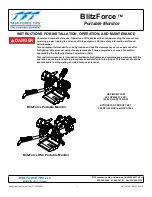
4 - 1
4
Using the Equipment
4.1
Operating Safety Information
DANGER
•
Avoid contact between parts of the patient’s body such as exposed skin of head or limbs, conductive
fluids such as gel, blood, or saline, and metal objects such as a bed frame or a stretcher which may
provide unwanted pathways for the defibrillating current.
WARNING
•
The equipment automatically removes the stored energy internally in following conditions.
◆
A rhythm change is detected and a shock is no longer appropriate.
◆
Electrode pads malfunction is detected.
◆
The Shock button is not pressed within 30s on the semi-automatic models.
•
Performing CPR or otherwise handling or moving the patient during rhythm analysis can cause
incorrect or delayed analysis.
•
For safety reasons, some low-amplitude or low-frequency heart rhythms as well as some VT rhythms
may not be interpreted as shockable rhythms.
•
During defibrillation, air pockets between the skin and the electrode pads can cause patient skin
burns. To help prevent air pockets, make sure the electrode pads are completely adhered to the skin.
•
During defibrillation, never press the Adult/Child mode switch to the Adult mode when using
pediatric pads for children. Otherwise the electrode pads might be damaged and could result in
delayed analysis.
•
Do not use dried-out electrode pads.
CAUTION
•
Prevent the electrode pads from contamination by dust or water before they are attached to the
patient. Otherwise, incorrect or delayed analysis may result.
NOTE
•
Use pediatric pads for children. If pediatric pads are not available, you can use adult pads, press the
Adult/Child mode switch to the Child mode and apply the electrode pads.
•
If MR62/MR63 electrode pads are used, the equipment automatically recognizes the patient type
after power on. When the current patient type is found to be inconsistent with the pad type, you
need to manually change the patient type.
•
If needed, perform CPR when there is delay or interruption in using of the equipment.
•
Successful resuscitation is dependent on many variables specific to the patient’s physiological state
and the circumstances surrounding the patient event. Failure to have a successful patient outcome is
not a reliable indicator of defibrillator/monitor performance. The presence or absence of a muscular
response to the transfer of energy during electrical therapy is not a reliable indicator of energy
delivery or device performance.
•
In emergency, if there are no spare pads nearby, continue patient treatment with the expired
electrode pads and ignore pads related prompts.
•
Motion artifact may delay analysis or affect the ECG signal resulting in an inappropriate shock or no
shock advised message. Keep the patient still during ECG rhythm analysis.
•
For the semi-automatic models, the Shock button must be pressed to deliver a shock. The
equipment will not automatically deliver a shock.
Содержание BeneHeart C Series
Страница 2: ......
Страница 10: ...4 This page intentionally left blank ...
Страница 14: ...1 4 This page intentionally left blank ...
Страница 22: ...3 4 This page intentionally left blank ...
Страница 34: ...6 4 This page intentionally left blank ...
Страница 40: ...8 4 This page intentionally left blank ...
Страница 42: ...9 2 9 2 Miscellaneous Description Model PN Disposable battery LM34S002A 022 000411 00 ...
Страница 50: ...A 8 This page intentionally left blank ...
Страница 64: ...E 4 This page intentionally left blank ...
Страница 68: ...F 4 This page intentionally left blank ...
Страница 70: ...G 2 This page intentionally left blank ...
Страница 72: ...H 2 This page intentionally left blank ...
Страница 74: ......
Страница 75: ...I 1 I Declaration of Conformity ...
Страница 76: ...I 2 ...
Страница 77: ......
Страница 78: ...P N 046 012619 00 2 0 ...















































